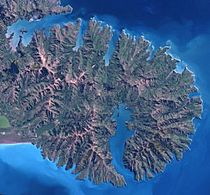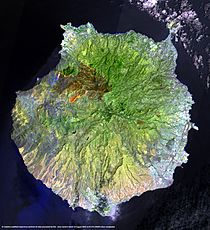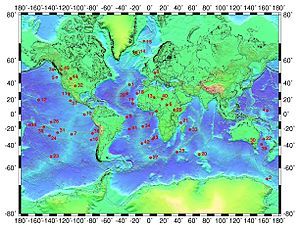Timeline of volcanism on Earth facts for kids
This timeline explores some of Earth's biggest volcanic eruptions. These are eruptions that were super powerful, often rated at least a 6 on the Volcanic Explosivity Index (VEI). The VEI is like a scale that measures how big a volcanic eruption is. Some of these eruptions released huge amounts of gas, like sulfur dioxide, which can even cool down the Earth's climate for a while, causing a "volcanic winter".
This list mainly focuses on eruptions from the last 2.58 million years, a time called the Quaternary period. For older eruptions, it's harder to find exact details because time has erased some of the evidence. You'll see some volcanoes appear many times, like Santorini and the Yellowstone hotspot, because they've had many big eruptions over history.
Contents
Earth's Biggest Volcanic Eruptions
Recent Big Eruptions (1000–2000 AD)
- Pinatubo, Philippines; June 15, 1991; VEI 6. This eruption shot out about 6 to 16 cubic kilometers of ash and rock. It also released around 20 million tons of sulfur dioxide gas.
- Novarupta, Alaska; June 6, 1912; VEI 6. This volcano erupted about 13 to 15 cubic kilometers of lava.
- Santa Maria, Guatemala; October 24, 1902; VEI 6. It released about 20 cubic kilometers of ash and rock.
- Krakatoa, Indonesia; August 26–27, 1883; VEI 6. This eruption produced about 21 cubic kilometers of ash and rock.
- Mount Tambora, Indonesia; April 10, 1815; VEI 7. This was a massive eruption, sending out 160 to 213 cubic kilometers of ash and rock. It also released about 200 million tons of sulfur dioxide, which led to the "Year Without a Summer" in 1816.
- 1808 mystery eruption, 1808; VEI 6–7. Scientists found evidence of this eruption in ice cores, but its exact location is still a mystery.
- Grímsvötn, Iceland; 1783–1785; Laki; 1783–1784; VEI 2. This eruption released 14 cubic kilometers of lava and about 120 million tons of sulfur dioxide, causing a volcanic winter in the Northern Hemisphere in 1783.
- Long Island (Papua New Guinea), Northeast of New Guinea; 1660; VEI 6. About 30 cubic kilometers of ash and rock were erupted.
- Huaynaputina, Peru; February 19, 1600; VEI 6. This volcano released 30 cubic kilometers of ash and rock.
- Billy Mitchell, Papua New Guinea; 1580; VEI 6. It erupted about 14 cubic kilometers of ash and rock.
- Bárðarbunga, Iceland; 1477; VEI 6. This eruption produced 10 cubic kilometers of ash and rock.
- 1465 mystery eruption, 1465; VEI 7. The location of this eruption is unknown, but it might have been even bigger than Mount Tambora's eruption in 1815.
- 1452/1453 mystery eruption, Vanuatu; 1452–1453; VEI 6–7. This eruption in the South Pacific was identified from ice cores. It released 36 to 96 cubic kilometers of ash and rock.
- Quilotoa, Ecuador; 1280; VEI 6. This eruption sent out 21 cubic kilometers of ash and rock.
- 1257 Samalas eruption, Lombok, Indonesia; 1257; VEI 7. This eruption released 40 cubic kilometers of dense rock. Ice cores from the Arctic and Antarctic show a big spike in sulfate from this volcano.
Looking Back: Eruptions in the Last 2000 Years
Here's a quick look at 27 major eruptions from the last 2000 years that had a VEI of 6 or higher. On average, that's about one big eruption every century!
| Volcano Name | Location | VEI | Date | What Happened |
|---|---|---|---|---|
| Mount Pinatubo | Luzon Volcanic Arc | 6 | 1991, Jun 15 | Global temperature dropped by 0.4 °C |
| Novarupta | Aleutian Range | 6 | 1912, Jun 6 | |
| Santa María | Central America Volcanic Arc | 6 | 1902, Oct 24 | |
| Krakatoa | Sunda Arc | 6 | 1883, Aug 26–27 | At least 30,000 people died |
| Mount Tambora | Lesser Sunda Islands | 7 | 1815, Apr 10 | Caused the "Year Without a Summer" (1816) |
| 1808 mystery eruption | Southwestern Pacific Ocean | 6 | 1808, Dec | Left a sulfate spike in ice cores |
| Long Island (Papua New Guinea) | Bismarck Volcanic Arc | 6 | 1660 | |
| Huaynaputina | Andes, Central Volcanic Zone | 6 | 1600, Feb 19 | Contributed to the Russian famine of 1601–1603 |
| Billy Mitchell | Bougainville & Solomon Is. | 6 | 1580 | |
| Bárðarbunga | Iceland | 6 | 1477 | |
| 1458 mystery eruption | Unknown | 6-7 | 1458 | Possibly larger than Mount Tambora's |
| 1452/1453 mystery eruption | Unknown | 6-7 | 1452–53 | Might have caused a "pulse" of the Little Ice Age |
| Quilotoa | Andes, Northern Volcanic Zone | 6 | 1280 | |
| Samalas (Mount Rinjani) | Lombok, Lesser Sunda Islands | 7 | 1257 | Might have started the Little Ice Age |
| Baekdu Mountain/Tianchi eruption | China/ North Korea border | 7 | 946, Nov-947 | Had limited effects on the climate nearby. |
| Ceboruco | Trans-Mexican Volcanic Belt | 6 | 930 | |
| Dakataua | Bismarck Volcanic Arc | 6 | 800 | |
| Pago | Bismarck Volcanic Arc | 6 | 710 | |
| Mount Churchill | eastern Alaska, USA | 6 | 700 | |
| Rabaul caldera | Bismarck Volcanic Arc | 6 | 683 (estimated) | |
| Volcanic winter of 536 | Unknown | 6-7 | 535 | |
| Ilopango | Central America Volcanic Arc | 6 | 450 | |
| Ksudach | Kamchatka Peninsula | 6 | 240 | |
| Taupo Caldera/Hatepe eruption | Taupo Volcano | 7 | 180 or 230 AD | Its ash affected skies over Rome and China |
| Mount Churchill | eastern Alaska, USA | 6 | 60 AD | |
| Ambrym | New Hebrides Arc | 6 | 50 AD | |
| Apoyeque | Central America Volcanic Arc | 6 | 50 BC (around this time) |
Ancient Giant Eruptions (Earlier Quaternary)
The Quaternary period, which includes the Pleistocene epoch, started about 2.58 million years ago.
- Eifel hotspot, Laacher See, Germany; 12,900 years ago; VEI 6. It produced about 6 cubic kilometers of ash and rock.
- Emmons Lake Caldera, Alaska; 17,000 years ago. More than 50 cubic kilometers of ash and rock were erupted.
- Lake Barrine, Australia; formed over 17,000 years ago.
- Menengai, Kenya; 29,000 years ago.
- Morne Diablotins, Dominica; VEI 6; 30,000 years ago.
- Phlegraean Fields, Italy; VEI 7; 40,000 years ago.
- Kurile Lake, Russia; 41,500 years ago; VEI 7.
- Maninjau Caldera, West Sumatra; VEI 7; around 52,000 years ago. It released 220 to 250 cubic kilometers of ash and rock.
- Lake Toba, Sumatra, Indonesia; VEI 8; 73,000 years ago. This was a super-eruption, sending out 2500 to 3000 cubic kilometers of ash and rock. It likely released six gigatons of sulfur dioxide.
- Atitlán Caldera, Guatemala; 84,000 years ago; VEI 7. It produced 300 cubic kilometers of ash and rock.
- Mount Aso, Japan; 90,000 years ago. Its last eruption was over 600 cubic kilometers of ash and rock.
- Sierra la Primavera, Mexico; 95,000 years ago. It erupted 20 cubic kilometers of ash.
- Mount Aso, Japan; 120,000 years ago; 80 cubic kilometers of ash and rock.
- Mount Aso, Japan; 140,000 years ago; 80 cubic kilometers of ash and rock.
- Puy de Sancy, France; inactive for about 220,000 years.
- Emmons Lake Caldera, Alaska; 233,000 years ago. More than 50 cubic kilometers of ash and rock were erupted.
- Mount Aso, Japan; 270,000 years ago; 80 cubic kilometers of ash and rock.
- Uzon-Geyzernaya calderas, Russia; 325,000–175,000 years ago. It left 20 cubic kilometers of ignimbrite deposits.
- Diamante Caldera–Maipo volcano complex, Argentina-Chile; 450,000 years ago. It erupted 450 cubic kilometers of ash and rock.
- Yellowstone hotspot; Yellowstone Caldera; 640,000 years ago; VEI 8. This super-eruption produced over 1000 cubic kilometers of ash and rock.
- Three Sisters (Oregon), USA; 600,000–170,000 years ago.
- Uinkaret volcanic field, Arizona, USA; 725,000–100,000 years ago. Lava flows from here blocked the Colorado River many times.
- Long Valley Caldera, California, USA; 758,900 years ago; VEI 7. It produced 600 cubic kilometers of ash.
- Valles Caldera, New Mexico, USA; 1.25 million years ago; VEI 7. It erupted around 600 cubic kilometers of ash.
- Sutter Buttes, California, USA; formed over 1.5 million years ago by an extinct volcano.
- Valles Caldera, New Mexico, USA; 1.61 million years ago; VEI 7. It erupted over 500 cubic kilometers of ash.
- Ebisutoge-Fukuda tephras, Japan; 1.75 million years ago. It produced 380 to 490 cubic kilometers of ash and rock.
- Yellowstone hotspot; Island Park Caldera; 2.1 million years ago; VEI 8. This super-eruption produced 2450 cubic kilometers of ash.
- Cerro Galán, Argentina; 2.2 million years ago; VEI 8. It erupted 1050 cubic kilometers of ignimbrite.
Older Eruptions (Neogene Period)
The Neogene period began about 23.03 million years ago.
Pliocene Eruptions
The Pliocene epoch began about 5.332 million years ago. For most eruptions before the Quaternary period, we don't know their VEI.
- Boring Lava Field, Oregon, USA; active at least 2.7 million years ago, extinct for about 300,000 years.
- Norfolk Island, Australia; a remnant of a volcano active around 2.3 to 3 million years ago.
- Pastos Grandes Caldera, Bolivia; 2.9 million years ago; VEI 7. It produced over 820 cubic kilometers of ignimbrite.
- Little Barrier Island, New Zealand; erupted from 1 million to 3 million years ago.
- Mount Kenya; formed about 3 million years ago.
- Pacana Caldera, Chile; 4 million years ago; VEI 8. This super-eruption produced 2500 cubic kilometers of ignimbrite.
- Frailes Plateau, Bolivia; 4 million years ago. It erupted 620 cubic kilometers of ignimbrite.
- Cerro Galán, Argentina; 4.2 million years ago. It produced 510 cubic kilometers of ash and rock.
- Yellowstone hotspot, Heise volcanic field, Idaho; Kilgore Caldera; 4.45 million years ago; VEI 8. It produced 1800 cubic kilometers of ash.
- Khari Khari Caldera, Bolivia; 5 million years ago. It produced 470 cubic kilometers of ash and rock.
Miocene Eruptions
The Miocene epoch began about 23.03 million years ago.


- Cerro Guacha, Bolivia; 5.6–5.8 million years ago.
- Lord Howe Island, Australia; formed from lava flows about 6.4 million years ago.
- Yellowstone hotspot, Heise volcanic field, Idaho; 5.51 million years ago.
- Yellowstone hotspot, Heise volcanic field, Idaho; 5.6 million years ago. It produced 500 cubic kilometers of ash.
- Cerro Panizos, Bolivia; 6.1 million years ago. It produced 652 cubic kilometers of ignimbrite.
- Yellowstone hotspot, Heise volcanic field, Idaho; 6.27 million years ago.
- Yellowstone hotspot, Heise volcanic field, Idaho; Blacktail Caldera; 6.62 million years ago. It produced 1500 cubic kilometers of ash.
- Pastos Grandes Caldera, Bolivia; 8.3 million years ago. It produced 652 cubic kilometers of ignimbrite.
- Manus Island, Papua New Guinea; 8–10 million years ago.
- Banks Peninsula, New Zealand; Akaroa erupted 9 million years ago, Lyttelton erupted 12 million years ago.
- Mascarene Islands; formed 8–10 million years ago.
- Yellowstone hotspot, Twin Fall volcanic field, Idaho; 8.6 to 10 million years ago.
- Yellowstone hotspot, Grey's Landing Supereruption, Idaho; 8.72 million years ago. It produced 2,800 cubic kilometers of ignimbrite.
- Yellowstone hotspot, McMullen Supereruption, Idaho; 8.99 million years ago. It produced 1,700 cubic kilometers of volcanic material.
- Yellowstone hotspot, Picabo volcanic field, Idaho; 10.21 million years ago.
- Mount Cargill, New Zealand; its last eruptions ended about 10 million years ago.
- Yellowstone hotspot, Bruneau-Jarbidge volcanic field; 10.0 to 12.5 million years ago.
- Anahim hotspot, British Columbia, Canada; has been active for the last 13 million years.
- Yellowstone hotspot, Owyhee-Humboldt volcanic field, Nevada/ Oregon; around 12.8 to 13.9 million years ago.
- Tejeda Caldera, Gran Canaria, Spain; 13.9 million years ago. This 80 cubic kilometer eruption produced a mix of volcanic materials.
- Gran Canaria shield basalt eruption, Spain; 14.5 to 14 million years ago. It produced 1,000 cubic kilometers of basalt lava.
- Campi Flegrei, Italy; 14.9 million years ago. It produced 79 cubic kilometers of ash.
- Huaylillas Ignimbrite, Bolivia, Peru, Chile; 15 million years ago. It produced 1100 cubic kilometers of ash and rock.
- Yellowstone hotspot, McDermitt volcanic field (North), Oregon; 15 million years ago. It produced 40 cubic kilometers of ash.
- Yellowstone hotspot (?), Lake Owyhee volcanic field; 15.0 to 15.5 million years ago.
- Yellowstone hotspot, McDermitt volcanic field (South), Nevada/ Oregon; 15.6 million years ago. It produced 350 cubic kilometers of ash.
- Yellowstone hotspot, McDermitt volcanic field (South), Longridge Caldera, Nevada/ Oregon; 15.6 million years ago. It produced 400 cubic kilometers of ash.
- Yellowstone hotspot, McDermitt volcanic field (South), Nevada/ Oregon; 15.7 million years ago. It produced 300 cubic kilometers of ash.
- Yellowstone hotspot, McDermitt volcanic field (South); 16 million years ago.
- Yellowstone hotspot, McDermitt volcanic field (North), Oregon; 15.8 million years ago. It produced 40 cubic kilometers of ash.
- Yellowstone hotspot, McDermitt volcanic field (South), Nevada/ Oregon; 16.548 million years ago. It produced 250 cubic kilometers of ash.
- Yellowstone hotspot (?), Northwest Nevada volcanic field; 15.5 to 16.5 million years ago.
- Yellowstone hotspot, Steens and Columbia River flood basalts, USA; most active from 14–17 million years ago. These eruptions produced a massive 180,000 cubic kilometers of lava.
- Mount Lindesay (New South Wales), Australia; part of an extinct volcano that stopped erupting about 17 million years ago.
- Oxaya Ignimbrites, northern Chile; 19 million years ago. It produced 3000 cubic kilometers of ash and rock.
- Pemberton Volcanic Belt, Canada; erupted about 21 to 22 million years ago.
Even Older Volcanic Events
The Paleogene period ended 23 million years ago.
- The Chilcotin Group basalts formed between 10–6 million years ago.
- The Columbia River Basalt Group formed between 17 and 6 million years ago.
- La Garita Caldera, Colorado, USA; erupted about 27.8 million years ago. This was a super-eruption, possibly a VEI 9, blasting out 5000 cubic kilometers of ash.
- An unknown source in Ethiopia erupted 29 million years ago with at least 3000 cubic kilometers of ash.
- Sam Ignimbrite in Yemen formed 29.5 million years ago, with at least 5550 cubic kilometers of ash.
- Jabal Kura’a Ignimbrite in Yemen formed 29.6 million years ago, with at least 3700 cubic kilometers of ash.
- The Ethiopian Highlands flood basalt began 30 million years ago.
- The Oligocene epoch of the Paleogene period began about 33.9 million years ago.
- The Mid-Tertiary ignimbrite flare-up began 40 million years ago and lasted until 25 million years ago.
- Bennett Lake Volcanic Complex erupted 50 million years ago with a VEI 7, producing 850 cubic kilometers of ash and rock.
- Canary hotspot is thought to have first appeared about 60 million years ago.
- The Brito-Arctic province began forming 61 million years ago.
- Réunion hotspot, Deccan Traps, India; formed between 60 and 68 million years ago. These eruptions are believed to have played a role in the extinction event that wiped out the dinosaurs.
- The Louisville hotspot has been active for at least 80 million years.
- Hawaii hotspot, Meiji Seamount is the oldest volcano in the Hawaiian-Emperor seamount chain, estimated to be 82 million years old.
- The Kerguelen Plateau began forming 110 million years ago.
- The Rahjamal Traps formed from 117–116 million years ago.
- The Ontong Java Plateau formed from 125–120 million years ago.
- Paraná and Etendeka traps, Brazil, Namibia and Angola; formed 128 to 138 million years ago. A possible supervolcanic eruption occurred 132 million years ago, ejecting 8600 cubic kilometers of material.
- The Karoo-Ferrar flood basalts began forming 183 million years ago.
- The flood basalts of the Central Atlantic magmatic province are thought to have contributed to the Triassic–Jurassic extinction event about 199 million years ago.
- The Siberian Traps are thought to have played a big role in the Permian–Triassic extinction event 252 million years ago.
- The Emeishan Traps began forming 260 million years ago.
- The Late Devonian extinction occurred about 374 million years ago.
- The Ordovician–Silurian extinction event occurred between 450 and 440 million years ago.
- Glen Coe, Scotland; VEI 8; 420 million years ago.
- Scafells, England; VEI 8; during the Ordovician period (488.3–443.7 million years ago).
- Flat Landing Brook; VEI 8. A supervolcanic eruption occurred 466 million years ago, one of the largest known, with 2,000–12,000 cubic kilometers of material.
- The Phanerozoic eon began 539 million years ago.
- Midcontinent Rift System of North America began forming 1,000 million years ago.
- Mackenzie Large Igneous Province formed 1,270 million years ago.
- Mistassini dike swarm and Matachewan dike swarm formed 2,500 million years ago.
- Blake River Megacaldera Complex formed 2,704–2,707 million years ago.
- The Proterozoic eon of the Precambrian period began approximately 2,500 million years ago.
- The Archean eon of the Precambrian period began about 3,800 million years ago.
See also
- Decade Volcanoes
- Dense-rock equivalent
- Volcanic winter of 536
- Geologic timeline of Western North America
- Hotspot (geology)
- List of largest volcanic eruptions
- List of volcanoes in Iceland
- List of volcanoes in Mexico
- List of volcanoes in Papua New Guinea
- Lists of volcanoes
- Ring of Fire
- Stratospheric sulfur aerosols
- Supervolcano
- Trans-Mexican Volcanic Belt
- Volcanic arc
- Volcanic Explosivity Index
- Volcanic winter
- Year Without a Summer


